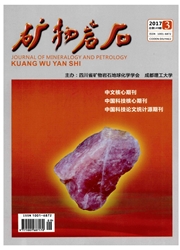

 中文摘要:
中文摘要:
对萨嘎地区古近纪海相沉积放射虫化石和上覆陆相沉积年代学研究证实,原古近系折巴群包含了早白垩世-早始新世不同时代的沉积,而不整合在其上陆相磨拉石沉积时代为早始新世中晚期(41.2 Ma-46.2 Ma)。变形分析表明萨嘎地区原古近系折巴群经历了强烈复杂的构造变形,不同时代的沉积岩系呈构造岩片在空间上重复叠置,表现出典型构造岩石地层单元的特点。萨嘎地区海相沉积岩系中始新世早期放射虫化石的发现和构造属性的确定,表明始新世早期沿萨嘎一线存在一定规模的特提斯海盆,特提斯洋的最终关闭和印度-欧亚板块全面碰撞造山作用发生于早始新世中晚期,并在此后发育与碰撞造山作用相关的磨拉石沉积。
 英文摘要:
英文摘要:
The stratigraphic age, division and tectonic attributes in Saga area, Southern Tibet provide much evidence on the evolution of Tethys and Indo-Asian collision. By the radiolarians research on the Paleogene Zheba Group in Saga region,it can be recognized that this marine stratum is comprised of Early Cretaceous-Early Eocene deposits and the molassic deposits lay over the marine sediments are 41.2 Ma- 46. 2 Ma. Structure analysis reveals that Zheba Group have undergone strong deformation and formed different tectonic slices with differnent age. These tectonic slices distributed disorderly and show the characteristics of tectono-stratigraphic units. The discovery and documentation of Early Eocene radiolarian assemblages in Saga area indicate that there was a deep sea in Saga area during early Eocene and the Indo and Asian continents collision took place during middle-late stage of early Eocene, followed by the formation of molasse after collision.
 同期刊论文项目
同期刊论文项目
 同项目期刊论文
同项目期刊论文
 Geochemical characteristics and genetic analysis of the Cretaceous dolomite in the Cuoqin Basin, Qin
Geochemical characteristics and genetic analysis of the Cretaceous dolomite in the Cuoqin Basin, Qin A Simple Analysis of Influential Factors for Cretaceous Marine Organic-rich Sediments in Southern Ti
A Simple Analysis of Influential Factors for Cretaceous Marine Organic-rich Sediments in Southern Ti 期刊信息
期刊信息
